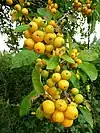Malus sylvestris
Malus sylvestris, the European crab apple, is a species of the genus Malus, native to Europe. Its scientific name means "forest apple" and the truly wild tree has thorns.
| Malus sylvestris | |
|---|---|
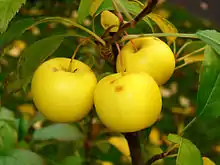 | |
| Scientific classification | |
| Kingdom: | Plantae |
| Clade: | Tracheophytes |
| Clade: | Angiosperms |
| Clade: | Eudicots |
| Clade: | Rosids |
| Order: | Rosales |
| Family: | Rosaceae |
| Genus: | Malus |
| Species: | M. sylvestris |
| Binomial name | |
| Malus sylvestris | |
Description
Wild apple has an expanded crown and often appears more like a bush than a tree. It can live 80–100 years and grow up to 10 m tall with trunk diameters of 23–45 cm. Due to its weak competitiveness and high light requirement, wild apple is found mostly at the wet edge of forests, in farmland hedges or on very extreme, marginal sites. The tree is rather rare but native to most European countries. It occurs in a scattered distribution pattern as single individuals or in small groups.[2]
Progenitor of cultivated apples
In the past M. sylvestris was thought to be the most important ancestor of the cultivated apple (M. domestica), which has since been shown to have been originally derived from the central Asian species M. sieversii.[3] However another recent DNA analysis[4] confirms that M. sylvestris has contributed significantly to the genome.
The study found that secondary introgression from other species of the genus Malus has greatly shaped the genome of M. domestica, with M. sylvestris being the largest secondary contributor. It also found that current populations of M. domestica are more closely related to M. sylvestris than to M. sieversii. However, in more pure strains of M. domestica, the M. sieversii ancestry still predominates.
The flowers are hermaphrodite and are pollinated by insects.
Pests
Its leaves are food of the caterpillars of the twin-spotted sphinx (Smerinthus jamaicensis) and possibly the hawthorn moth (Scythropia crataegella).
Gallery
_-_geograph.org.uk_-_1310191.jpg.webp) Tree
Tree Blossoms at the Botanical Garden KIT, Karlsruhe, Germany
Blossoms at the Botanical Garden KIT, Karlsruhe, Germany At Vosseslag, Belgium
At Vosseslag, Belgium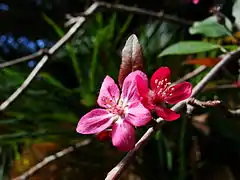 Pink blossom
Pink blossom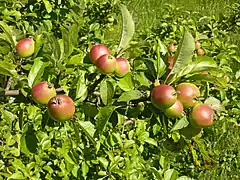 Ripe wild crab apples (Malus sylvestris)
Ripe wild crab apples (Malus sylvestris).JPG.webp) Close-up showing fruit and leaves (Southeast Michigan)
Close-up showing fruit and leaves (Southeast Michigan)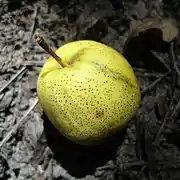 Fruit
Fruit
References
- "Malus sylvestris (Crab Apple, European Crab Apple, Pommier Sauvage)". Iucnredlist.org. 2010-04-16. Retrieved 2018-09-21.
- Stephan, B.R.; Wagner, I. & Kleinschmit, J. (2003), Wild apple and pear - Malus sylvestris/Pyrus pyraster: Technical guidelines of genetic conservation and use (PDF), European Forest Genetic Resources Programme, archived from the original (PDF) on 2016-10-20, retrieved 2016-10-20
- Velasco R., Zharkikh A., Affourtit J. et al., The genome of the domesticated apple (Malus × domestica Borkh.) Nature Genetics, 2010, 42, 10, 833
- Coart, E., Van Glabeke, S., De Loose, M., Larsen, A.S., Roldán-Ruiz, I. 2006. Chloroplast diversity in the genus Malus: new insights into the relationship between the European wild apple (Malus sylvestris (L.) Mill.) and the domesticated apple (Malus domestica Borkh.). Mol. Ecol. 15 (8): 2171-82.
Sources
- M.H.A. Hoffman, List of names of woody plants, Applied Plant Research, Boskoop 2005.
- RHS dictionary of gardening, 1992
External links
| Wikimedia Commons has media related to Malus sylvestris. |
- USDA Plants Profile for Malus sylvestris
- Jepson Manual (JM93) treatment of Malus sylvestris — introduced species in California.
- Malus sylvestris in the CalPhotos Photo Database, University of California, Berkeley
- EUFORGEN species page: Malus sylvestris. Information, distribution and related resources.

